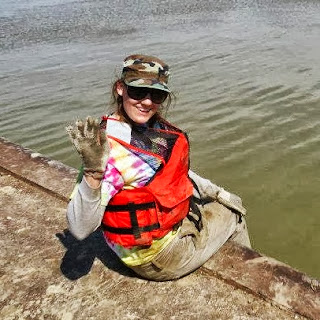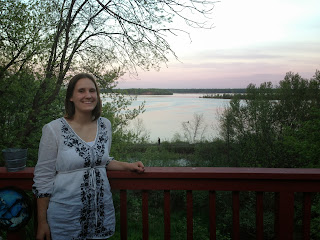February was a busy month for those interested in improving coastal outreach and education with social science. The topic took center stage at national and regional conferences. And IISG’s Caitie McCoy—along with other members of the Great Lakes Social Science Network—was onsite for each to discuss new research and provide tips for engaging the public, collecting reliable qualitative data, and evaluating projects.
It all started with the NOAA Social Coast Forum in South Carolina. During the two-day event, Caitie talked with representatives from academia, government agencies, non-profits, and the private sector about everything from how social science has improved risk communication to the best ways to engage Great Lakes tribes in sediment removal projects. The biggest draw, though, was her presentation on the effectiveness of a new severe weather warning system with fellow Sea Grant social scientists Jane Harrison and Hilarie Sorenson along with University of Wisconsin-Milwaukee student Katie Williams.
The system is part of NOAA’s Weather-Ready Nation, a collaborative project designed to boost community resilience to tornadoes, storm surges, and other extreme weather events. It is intended to keep broadcast meteorologists and emergency managers up-to-date on expected impacts with messages like “tornadic winds could throw automobiles into the air” and “the entire neighborhood will be destroyed.” Caitie, Jane, Hilarie, and New York Sea Grant’s Katherine Bunting-Howarth were brought on board to ensure that messages meet the needs of those who rely on them most when the big storms hit.
 Just a few days later, Caitie, Jane, Hilarie, and others brought social science information and recommendations to Superior, Wisconsin for the St. Louis River Estuary Summit. The summit brought together researchers, natural resource managers, educators, and members of the community interested in protecting this tributary to Lake Superior.
Just a few days later, Caitie, Jane, Hilarie, and others brought social science information and recommendations to Superior, Wisconsin for the St. Louis River Estuary Summit. The summit brought together researchers, natural resource managers, educators, and members of the community interested in protecting this tributary to Lake Superior.
For her part, Caitie reported on a needs assessment conducted last year to learn how local communities feel about remediation and restoration efforts in Spirit Lake, one of several sites that make up the St. Louis River Area of Concern. The case study uncovered several important views and concerns that will help Caitie and other members of the outreach team tailor their efforts to these communities. For example, learning that residents often struggle to see how remediation efforts fit together will help them design simple messages that connect cleaning up Spirit Lake with the ultimate goal of removing the St. Louis River from the AOC list. Although clean up won’t begin until at least 2015, the needs assessment has already influenced outreach and helped Caitie develop strong relationships within the community that will help the project move forward.
The St. Louis River cleanup and Caitie’s work to improve public engagement here and at other AOCs is possible because of the Great Lakes Restoration Initiative and the Great Lakes Legacy Act.
(Photo credits: Photo 1: St. Louis River AOC, courtesy of EPA
Photo 2: Caitie McCoy and former intern Emily Anderson near the St. Louis River AOC)
Emily Anderson graduated from Northern Illinois University this past spring and was able to put her studies to work right away as one of our summer interns. She wrote in to tell us about her experience working with Caitie McCoy on outreach and social science efforts related to sediment remediation.
“This summer I interned with Illinois-Indiana Sea Grant as the Human Dimensions of Natural Resources Intern. When I found the listing for the IISG Internship position I knew right away it was right for me. I was ecstatic to find a position that aligned with my interests in both psychology and environmental science, so I excitedly submitted my application and then waited nervously. Days after I walked across the stage as a 2013 graduate from Northern Illinois University, I relocated from DeKalb, Illinois to my new office on the University of Illinois’ campus.
Throughout the summer I traveled around the Great Lakes with my mentor Caitie McCoy and collected data on people’s perceptions of contaminated sediments. One of Sea Grant’s missions is to conduct research across the Great Lakes; as such, my job was to assist Caitie in conducting a study on two contaminated rivers slated for cleanup. In order to restore the health of the Great Lakes ecosystem and restore benefits to the local communities, the GLLA funds sediment remediation and habitat restoration in connecting waterways. The purpose of our research was to gain an understanding of how people in these communities relate to their river so that this information could be used to guide outreach efforts at these and other contaminated sites. We were also interested in the different benefits that communities receive from these waterways and how cleanup efforts might enhance those resources. In order to get a site-specific understanding we traveled to different locations and interviewed local leaders.
After learning about the background and purpose of the GLLA program, my first task was to recruit interview participants. I am rather shy normally, but conducting the recruitment communications and helping with the interviews was a great experience to break me out of my shell. I was pretty nervous during my first recruitment call, but after speaking with an extremely nice and generous person who invited us to go fishing during our interview I became much more comfortable. With help from our local outreach teams, we ended up with nearly 45 interviewees between our two sites (Duluth, MN and Sheboygan, WI).
I really love to travel, see new places, and learn new things so I have to say conducting the interviews was my favorite part of the internship. Both cities were beautiful in their unique way, and I’d definitely visit again if I got the chance. (In fact I’d consider living in Duluth despite an average of 80 inches of snowfall per year.) It was so interesting to get to listen to people’s stories and learn about the environmental issues in the Midwest. After the site visit I got right to work at transcribing the interviews which I will admit was not my favorite part of the experience but was a very valuable task and an opportunity to develop a new skill.
Before this internship most of the research I had been involved in was quantitative so the idea of data analysis guided by intuition was sort of foreign to me. At first I stumbled through the process but I found conceptual ground and eventually was able to enjoy qualitative analysis. Because of my concern for the health of the environment and my interest in social science it really gives me a great feeling to know that research like this is being conducted. In the end I feel accomplished; the study I helped with this summer will guide future outreach at the sites we visited and add to our understanding of the benefits of river cleanups. And ultimately that will help prove the real-world value and impact of programs like GLLA. This internship reaffirmed my passion for research and exposed me to a multitude of career options that are directly in line with my interests. I leave this position with a little more direction and a lot more hope for the future of the Great Lakes.”
Emily is one of four interns who worked with IISG this summer. You can read about Alice’s experience here, John’s here, and look forward to another post soon.
 Just a few days later, Caitie, Jane, Hilarie, and others brought social science information and recommendations to Superior, Wisconsin for the St. Louis River Estuary Summit. The summit brought together researchers, natural resource managers, educators, and members of the community interested in protecting this tributary to Lake Superior.
Just a few days later, Caitie, Jane, Hilarie, and others brought social science information and recommendations to Superior, Wisconsin for the St. Louis River Estuary Summit. The summit brought together researchers, natural resource managers, educators, and members of the community interested in protecting this tributary to Lake Superior. 






